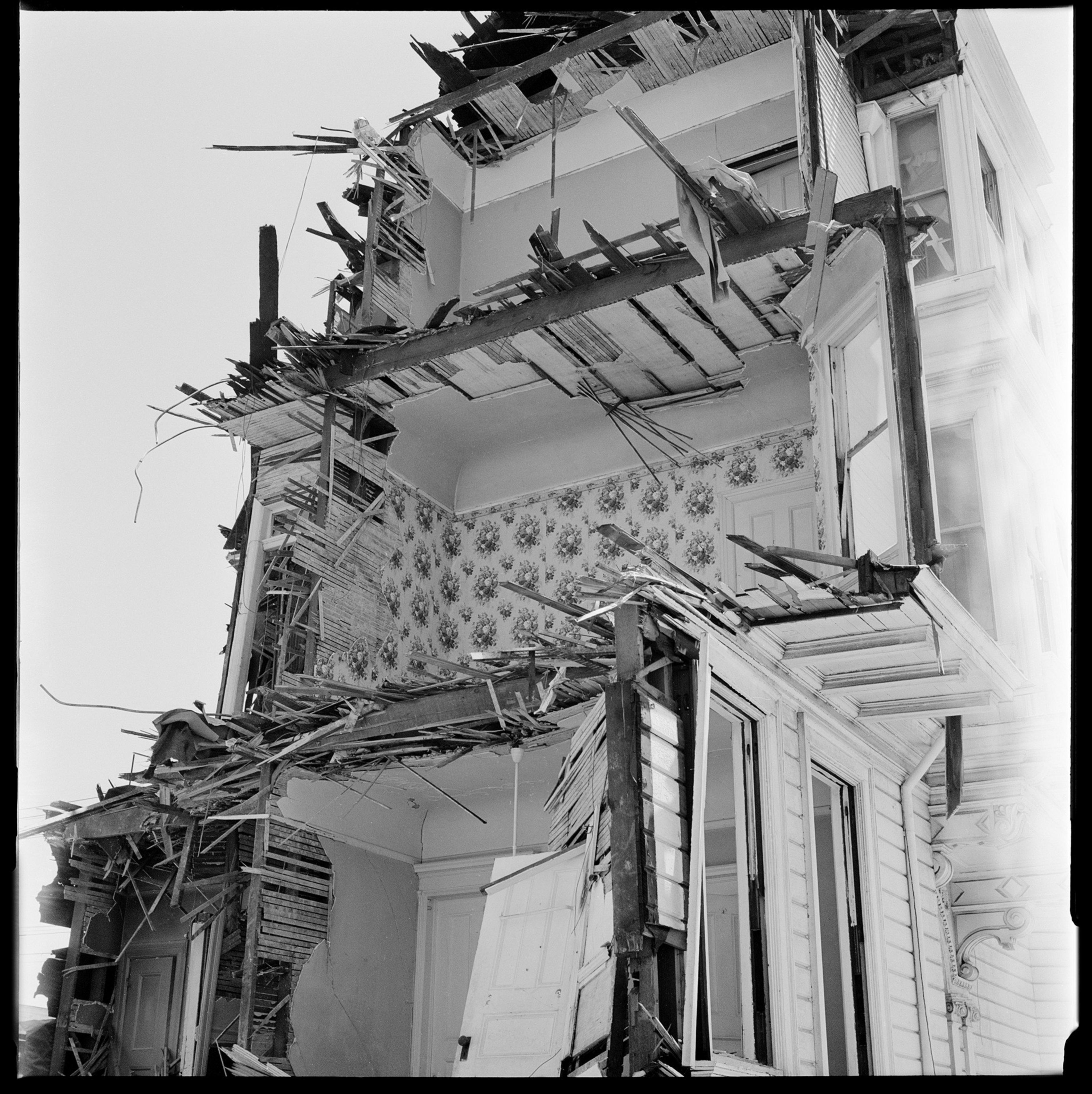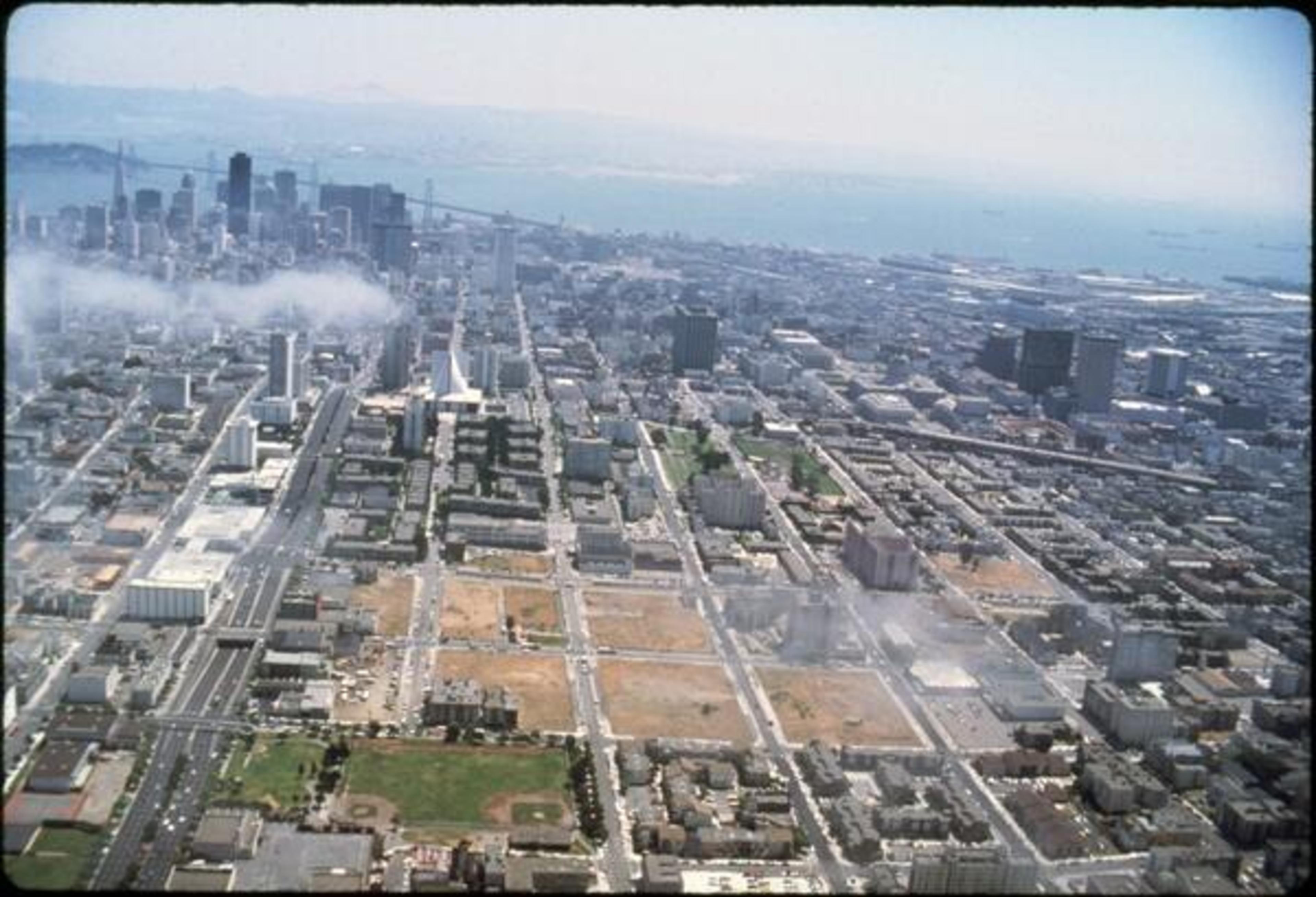This San Francisco story begins with a dying father’s wish.
“The last conversation I had with him was about these photographs,” said Ernest Burden III (opens in new tab), his voice cracking with emotion. He’s talking about his father Ernest Burden Jr.’s life work—an archive that includes 3,000 negatives documenting the destruction of the Fillmore District beginning in 1959 as part of the federally funded “urban renewal” project, intended to modernize cities.
“I promised I would get them shown in San Francisco and ultimately find a place for them in a museum,” Burden said.

Since his father’s death two years ago, the San Francisco-born artist, who now resides in Ossining, New York, is taking the initial steps in that journey. Last October, Burden presented the first set of prints at the 50th anniversary party for Freedom West, the housing cooperative being rebuilt (opens in new tab) for Fillmore residents. Now, in an exclusive with The Standard, Burden has chosen to make this incredible collection of negatives public for the first time.
“I felt his dad’s spirit looking at those pictures,” said Mattie Scott, who lives in Freedom West and attended the celebration. Scott grew up in the Fillmore in its glory days only to later see it razed to the ground. “He saw.”
In 1959, Ernest Burden Jr. was a 24-year-old architect not working on behalf of any city agency when he decided to document the looming destruction of the Fillmore, which had been condemned by city and federal authorities on the false premise of urban blight.
View Photos
Gallery of 4 photos
the slideshow
“It wasn’t like somebody was paying him to do this,” Burden said. “He just had the passion to record it.”
The vast collection amassed by Burden and his wife, Sheila Stover, includes 5,000 negatives as well as ephemera and drawings. The bulk of the archive is dedicated to the destruction of the Fillmore District—providing a visual umbilical cord back to the history of violence that ravaged the landscape of the neighborhood also known as the Western Addition.
“We always talked about it,” Scott said of the problematic history she wanted to share with her children, who were also raised in the Fillmore. “But they never saw it.”
Not until now.
‘People’s homes being torn apart’
For the younger Burden, it’s been a gradual journey to understanding the historical significance of the collection, its images portraying the destruction of a beloved neighborhood with a humanistic eye.
He had to take periodic breaks from sorting and cataloging the images, turning to research a history he only knew the bare outlines of.
“Working with them was really emotionally difficult,” Burden said. “Because it’s people’s homes being torn apart.”

Eventually, he contacted MacFarlane Partners, where he learned about the mission of Freedom West (opens in new tab) to create equitable housing development in the wake of a community torn apart.
“It felt like the redemption I was searching for as I was looking at these things and becoming overwhelmed,” he said.
The heartwrenching trove of never-before-seen images depict cranes’ jaws pawing their way through the Western Addition, transforming a once-thriving area—the most racially integrated neighborhood in the country—into a barren lot. Unlike the dispassionate, wide-angle images (opens in new tab) shot by the San Francisco Redevelopment Agency at the time, Burden’s images focus on the details.
But the bigger story begins with that ill-fated project of “urban renewal”—and the vibrant neighborhood leveled in its unfolding.
The Harlem of the West
Lewis Watts, the co-author of the book Harlem of the West: The San Francisco Fillmore Jazz Era moved to San Francisco with his family in 1964. One night, his friend asked him if he wanted to go to the Black neighborhood of the city.
“I went to the Fillmore on a Friday night, and it was incredible,” he said. “It was jam-packed with people dressed to the nines.”
Yet, when Watts went back in search of the neighborhood as a student at Berkeley in 1968, he couldn’t find it.
“It literally had been erased,” he said.

In search of evidence of this lost world with music pouring out of every door, he eventually went to a shoeshine shop. “In a black community, barbershops and beauty parlors and mortuaries are the historians,” he said.
There, he began to find evidence of that world he had glimpsed: lounge singers, bass players, those people dressed to the nines. He compiled the images for Harlem of the West, which was published in 2020. Watts’ work is a bit like the inverse of Burden’s photographic record, capturing the life and joy within the neighborhood before its devastation.
Mattie Scott remembers picking up her Easter dress, getting her hair done and going skating all within a few blocks’ radius. She can still rattle off the names of beloved local businesses: Dorothy’s, the Chicago Barbershop, the Booker T. Washington Motel.

“We didn’t have to go downtown for anything,” she said. “There was every ethnicity. It was just beautiful.”
In her memoir I Know Why the Caged Bird Sings, Maya Angelou described the Fillmore in its pre-urban renewal days.
“The street housed two day-and-night restaurants, two pool halls, four Chinese restaurants, two gambling houses, plus diners, shoeshine shops, beauty salons, barber shops and at least four churches.” These two blocks, Angelou wrote, were duplicated many times over in the eight- to 10-square-block area.
“In San Francisco, for the first time, I perceived myself as something,” she wrote.
The glorious memories of the pre-urban renewal Fillmore are part of what made the eventual loss all the more staggering.
“To see all those people flourish and thrive,” Scott said. “And then to lose all that.”
A vanished world
The impact of the Fillmore’s leveling continues to reverberate today, with San Francisco’s Black population never recovering (opens in new tab) the numbers it once had after Black residents were forced to move out of homes they had owned, and then were priced out from ever moving back.
The photographs also exhibit great artistic and technical merit, shot with the kind of scrupulous care required of a person who would go on to craft several thousand images of one neighborhood—a task that would have taken enormous time and attention in the pre-digital era.

“He was an accomplished photographer who knew what he was doing,” said Elizabeth Pepin Silva, the co-author of Harlem of the West: The San Francisco Fillmore Jazz Era and the associate producer of the KQED documentary The Fillmore. “They capture the act of destruction in a very visceral way.”
The demolition happened so quickly, starting at first in 1956 and a second stage in 1964, Silva said, that the time has almost faded into myth. While it’s possible to read and learn about what happened in the Fillmore, seeing the incredible violence in Burden’s images is an entirely different experience.
“You are there in that moment, feeling what’s going on,” she said.
“The images brought back a lot of memories and a lot of sadness about what happened to our community,” Scott said. “There were 800 businesses along Fillmore, all Black-owned.”
Burden described his father as meticulous and accurate. He appreciated aesthetics and was quick to point out the art he loved—and explain why he loved it. This attention to detail emerges in the photographs of the Burden Archive, like one in which he documents a man prying off Victorian ornamentation with a crowbar.

“That was part of telling the story,” Burden said of the image. “The city came in and destroyed everything, but some people picked the good stuff and took it.”
Those details, too, create a narrative. Floral-patterned wallpaper juxtaposed with ripped-apart beams, reminds you that someone once lived in the space being demolished, that they likely raised their children and heard stories from their elders alongside those walls.

In the archive of photographs produced by the San Francisco Redevelopment Agency, on the other hand, it’s the cold approach of a survey that reigns. Wide shots of buildings are devoid of detail, homes and businesses coldly marked with numbers that ultimately became the code for their destruction.
The collection of photographs from the Redevelopment Agency, housed in the San Francisco Public Library’s history room, also documents the justification of the destruction, as if images of a house in need of cosmetic repairs or a garbage-strewn kitchen could “prove” the buildings needed to be torn down. Then come the glossy photographs of reconstruction, razed lots with circular saws standing on them, miles of wood and heads in hard hats.
The photographic record reads entirely differently from the trove of photos in Burden’s collection, proving not even black-and-white images are black and white. There’s always an angle.
What’s next?
“It was an atrocity,” Scott said of the work done by the San Francisco Redevelopment Agency back in those years. “To see it all bulldozed and the lies told to us.”
While the Redevelopment Agency said the homes were not fit to live in due to their deteriorating condition—as early as 1942, editorials began appearing in local papers about the “slums” of the Fillmore—Scott and her neighbors watched entire Victorian homes being lifted up onto trailers and moved to Pacific Heights and other neighborhoods.
Indeed, archival photographs of the Redevelopment Agency held by the San Francisco Public Library in its history center document homes being uprooted and transported.

“If it has to be torn down, then why the hell are you moving it?” Scott asked.
For Silva, the experience of what happened in the Fillmore is a cautionary tale. “Every time San Francisco does things by governmental decree it ends up a hot mess,” she said. “I don’t think the city has learned.”
‘Not as half as bad as San Francisco’
“Oh, I’m gonna tell you about San Francisco,” a man says in the opening of the 1964 documentary (opens in new tab)Take This Hammer (opens in new tab) starring the novelist James Baldwin. “The South is not as half as bad as San Francisco.”
“He’s not taking advantage of you out in public like they do in Birmingham,” the man continues. “But he’s killing you with that pencil and paper.” Baldwin stands on the same devastated spots that Burden Jr. photographed just a few years prior. In a heartbreaking moment of the film, a Black man laments that the only job you can get in San Francisco is tearing down your own house.

The Burden Archive, though, focuses not only on what was destroyed. Burden III calls his father’s archive “A San Francisco Trinity”—it’s about what was lost, what was saved and what’s next. The collection contains hundreds of images of the Palace of Fine Arts, which Burden photographed before it was rebuilt. It also contains drawings for a never-realized art center, the arches of which were to be constructed with redwood salvaged from a Western Addition church.
Burden’s images of the razing of the Palace of Fine Arts are strikingly similar to the Fillmore collection, dichotomous depictions of beauty alongside destruction.
“The wreckers came, pulled down the palaces, smashed the pavilion domes and Italian towers, and scraped the luxuriantly gardened grounds bare as a desert,” Burden wrote in the 1967 book San Francisco’s Wildflower: The Palace of the Fine Arts. It’s an eerie echo of what happened in the Fillmore, but this time, the story has a less heart-wrenching ending—the reconstruction of the deteriorating landmark was completed in 1967.

The legacy of the federally funded destruction of the Fillmore, however, looms largest. At 3,000 images, it forms the bulk of the Burden Archive, documenting a dark chapter of history in a way never seen before.
“It did exactly what you want art to do,” Burden said. “Which is to bring out something from inside the viewer.”




